Background:
I came across a video of a car owner describing their experience working with Equilibrium Tuning, the seller of the Blaze intake, trying to identify the cause of a lower-than-expected turbocharger wastegate duty cycle (wgdc).
This presented an opportunity to evaluate the information another consumer used as the basis for recommending the Blaze ATOM V2 intake.

In previous checks, I have found that the Blaze intake was incorrectly identified as the primary factor affecting the reported change.

In this latest example, the person did a nice job going over the differences found in data logs using the two different intakes.

From the posted information we found out they were using a Vortex XL turbocharger and how changing to the Blaze ATOM V2 intake cleared up the low wgdc issue.
This information helped with establishing what the cross-sectional area of the turbo inlet is (56 mm), and what the outlet area of the turbo flange is (55.7 mm).
Clue Search:
However, they failed to describe the baseline product, and more importantly, the measurement of the outlet diameter of the baselined Turbo Inlet Elbow. This is an important factor in the response of interest, the wastegate duty cycle.
After looking around I found a discussion of the results that included a clue as to the identity of the unnamed components being used.
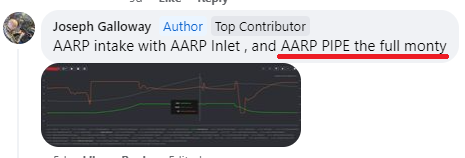
With clues from the discussion and videos, it’s possible to determine they were using an APR open intake, APR inlet hose, and APR Turbo Inlet Elbow.
Mismatch:
APR states the following about the recommended use of their turbo inlet elbow:
This upgrade is recommended at all stages utilizing an IHI IS12, IS20, or IS38 turbocharger!
Audi Performance and Racing

In the videos, the user never indicates why they chose a turbo inlet elbow made for a stock turbocharger to use with their larger hybrid turbocharger.
This was a fateful decision that later would be the self-inflicted cause for them making boost tests, smoke tests, and leak tests chasing a leak that didn’t exist.
The APR TIP is designed for use with a stock turbo, and even in that capacity it is a modest improvement in airflow over a stock inlet elbow. The APR TIP was flow-tested in 2018 and the product still ranks near the bottom of the inlet elbows I have tested in a stock turbo application.

The importance of matching the outlet diameter of the elbow to the inlet of the turbocharger compressor cover is significant.
It’s been shown previously in testing with the Integrated Engineering intake and CTS Turbo cast elbow (stock size) and DBV2 elbow (hybrid size) that when using a hybrid turbo (56 mm inlet) it’s possible to gain around 10% more airflow with the correct size elbow.

I also run through this point discussing the users’ information in this video:
Stats:
- APR outlet diameter is 48.7 mm, which is a cross-sectional area of 1863 mm sq.
- Blaze flange outlet diameter is 55.7 mm, which is a cross-sectional area of 2437 mm sq.
- The hybrid flange better matches the hybrid turbocharger inlet and opens up 30.8% more cross-sectional area for air to flow through.
With ~31% more area for air to flow through into the turbocharger, at the narrowest point of restriction, it is not a surprise that changing from the APR elbow to the Blaze flange correlated with a reduction in the turbocharger’s wastegate duty cycle.
Blaze Intake incorrect conclusion:
The user details in the video how they had concluded that the APR intake was the source of the problem and switched to the Blaze intake.
I’m like pulled the trigger, listened to the guys (EQT) and bought the Blaze intake.
Joseph Galloway
This was a costly solution since a Blaze ATOM V2 intake runs $550 plus shipping costs and taxes. A more cost-effective solution would have been to replace the stock design APR TIP with one suitable for use on a hybrid turbocharger.
As was shown in the flow test with the APR PEX intake joined with an MST inlet hose and DBV2 TIP the flow rate through the APR intake is slightly greater than through the Blaze ATOM V2 in a hybrid application:
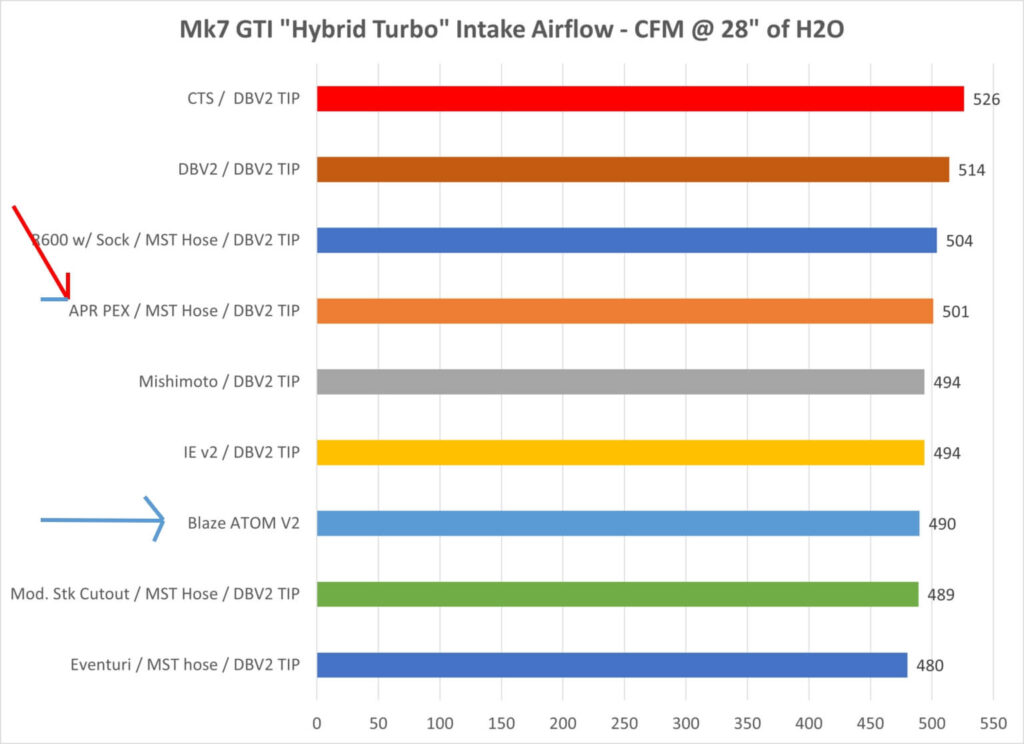
Dyno results:
Shortly after making the posts about how the Blaze intake solved the issue caused by the APR TIP, the user made a post comparing the results of their mismatched APR setup and the Blaze intake.
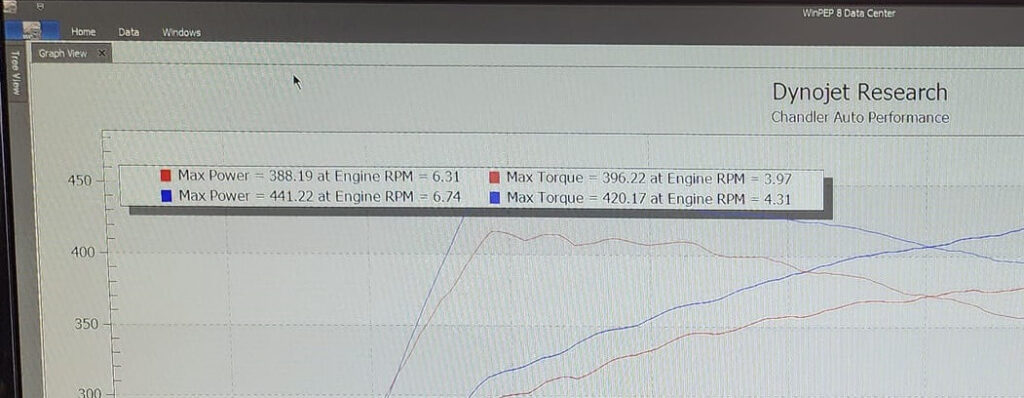
Their results verified the flow test results match well with dyno measurements.
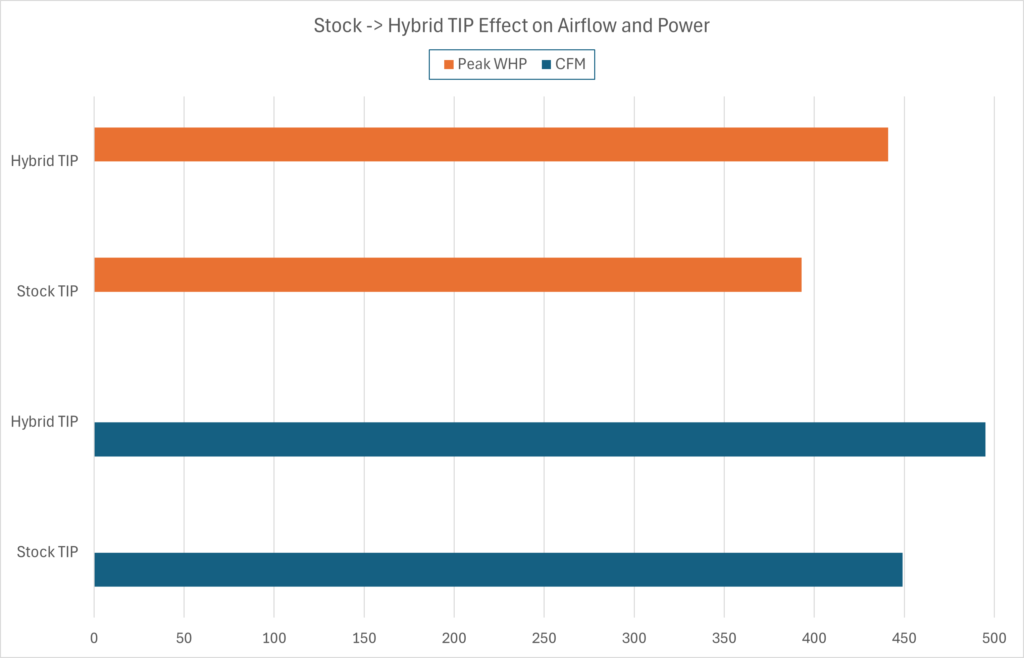
Note: In the chart, Stock refers to a TIP that is made to work with the stock turbocharger, not that the tip is the stock (OEM) part.
Confirmation Bias:
It didn’t take long for confirmation bias to set in concerning the supposedly poor-performing APR “intake“.
A confirmation bias is cognitive bias that favors information that confirms your previously existing beliefs or biases.
Verywell Mind


Even people thinking critically had an uphill battle because this information was posted on the EQT Fan Club FB page. EQT has a record of manipulative behavior, and they were not helping to set the record straight.
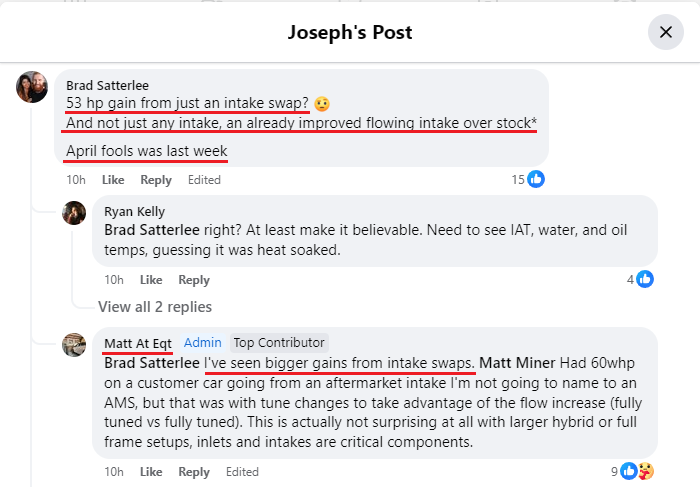
When not acting deceptively they ignored someone trying to get answers about the important parts of the comparison:

Flow test confusion:
As mentioned above, information about how important the turbo inlet elbow is to the overall system performance has been shown for years. So why are so many people lacking an understanding of this fact?
False statements like these from enthusiasts don’t help their fellow enthusiasts:

Note: As a matter of fact, every “real-world” comparison has validated the results made with the flow bench.
Then there’s team EQT seizing an opportunity to manipulate consumers by trying to undermine the credibility of flow testing:

Conclusions:
An enthusiast with a Vortex hybrid turbocharger selected an inappropriate turbo inlet elbow (TIP) for use with their turbocharger.
This mistake led to a series of unnecessary troubleshooting steps ultimately replacing all of the components in the pre-turbocharger intake with the $550 Blaze intake.
The wholesale replacement of the APR intake, inlet hose, and inlet elbow resolved the low wastegate duty cycle issue that had been observed.
This approach was not a cost-effective solution since the turbo inlet elbow (TIP) is known to be the most critical component of the pre-turbocharger intake parts.
The APR intake when paired with a hybrid-sized turbo inlet elbow flows similar to the Blaze ATOM V2 intake.
This is the sixth example of real-world data recorded using the Blaze ATOM V2 intake system where the person recording data concludes the intake as the source of differences when they were using a stock turbo-sized TIP.
The solution to the low wgdc issue was published on an EQT Fan Club page where members of EQT made misleading statements to consumers that reinforced the incorrect conclusion that the APR intake was the source of the issue.
If suppliers foster a misunderstanding among consumers, costly errors (to consumers), such as the one in this example, can happen.

I find the fact we ignore the data comparison of the face the blaze wgdc was lower then open compressor wheel humorous.
It was not ignored. Obtaining a lower WGDC with an intake attached compared to without isn’t too surprising. The intake is able to smooth airflow entering the turbo whereas an inlet elbow or the compressor housing alone will introduce more turbulence at the inlet and reduce the airflow rate. Also, the intake can pull in cooler air where an inlet elbow is going to be pulling in air that is inside the engine compartment and most likely a bit warmer. Both of those factors would increase the WGDC.
Here’s an example of a filter improving airflow through an intake:
AEM Intake Test – YouTube